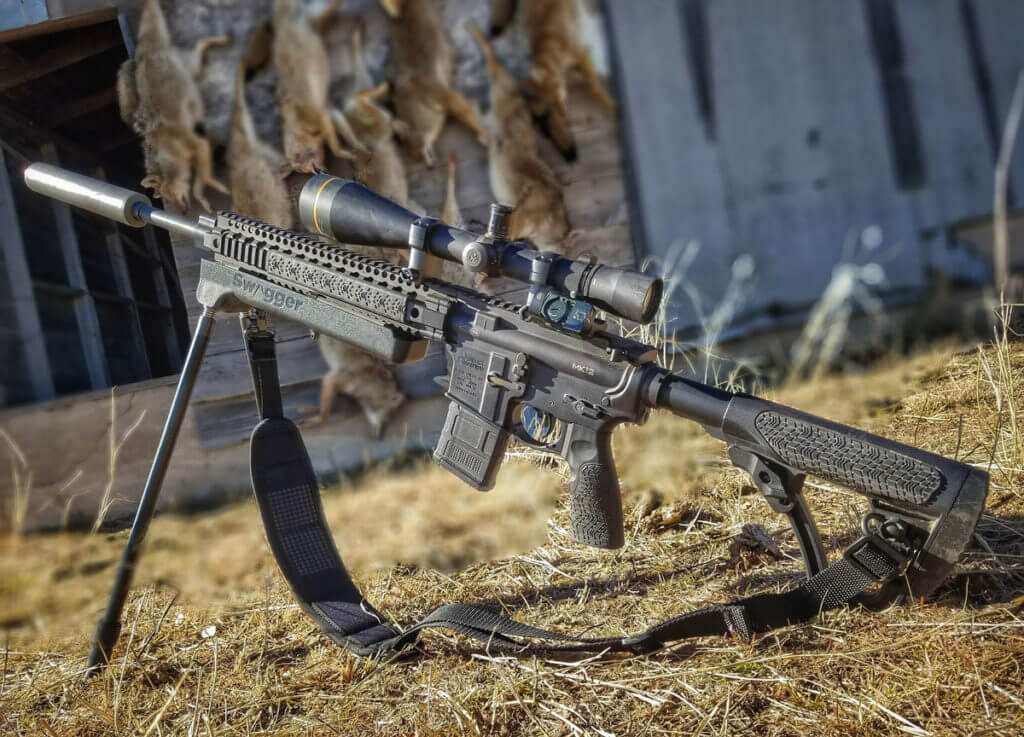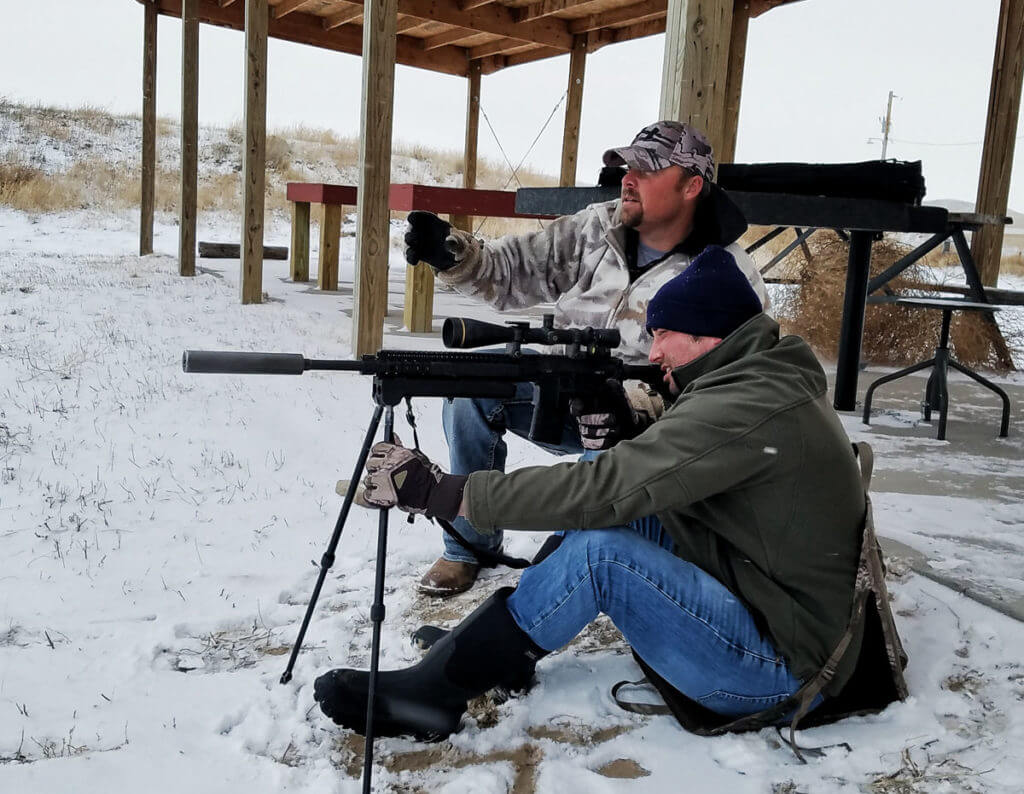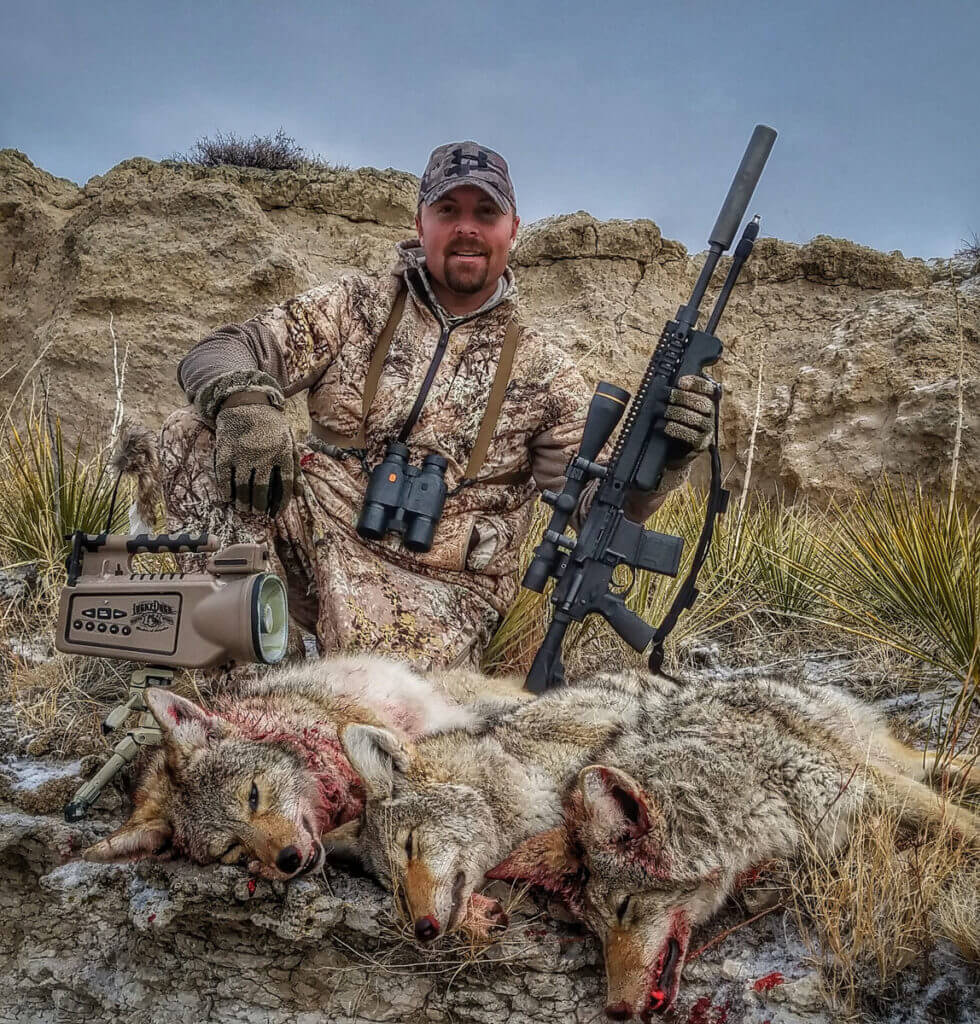
Over the last decade, the AR platform has gained popularity among coyote hunters and it’s easy to see why. Ideal cartridge size, semi-automatic capabilities, and the ability to customize the rifle are just a few of the reasons why black rifles have found a home in the world of coyote hunting. With many hunters making the switch from traditional bolt guns, buying an AR rifle and setting it up specifically for thumping coyotes is as clear as mud for most. For those who already own an AR but have it set up for tactical or home defense use, the struggle with converting it over to a hunting rifle is just as real. I made the switch in 2004 and over the last 15 years, I’ve experimented with many different setups. Below I’ll outline the main areas that need addressing in order to produce a tact-driving, coyote-smashing machine.
Optics
Just like with any great hunting rifle, topping your AR with the right optic is crucial for getting exceptional results. In the world of tactical and home defense shooting, the use of reflex-style sights is very common due to minimal shot distances and the need for quick target acquisition. When it comes to coyote hunting, you’re shooting at a small target over greater distances so using a scope with variable magnification is key. On my personal setup, I run a Leupold 6.5-20×50 LR VX3i. Some may think that is overkill but when you’re trying to settle in on a cantaloupe-sized target at over 250 yards, having the ability to zoom in the scope is advantageous! Being able to adjust the scope magnification based on the terrain and each individual coyote stand and situation is very important as well. Many hunters throughout the coyote hunting community prefer 3×9 or 4.5×14 variable powered scopes to accommodate for those variables. Although using the exact same scope I do might be a bit excessive for your personal needs, don’t cut yourself short when it comes to optics. Buy the best that you can afford, in a platform that will allow you clear target acquisition in low-light situations. Some of the best coyote hunting happens right before sunup or after sundown so having a scope with at least a 40mm objective lens will give you a greater chance at acquiring the target and making the shot. In most cases, your rifle is only as accurate as the scope you put on it!

Triggers
In my opinion, the trigger is probably the most important option when it comes to setting up your AR for coyote hunting! Shooting sub-MOA groups at 100 yards is a must if you want to consistently kill coyotes out to 300 yards. Having the right trigger in your rifle will allow you to make that happen. Not to say this isn’t possible with a mil-spec trigger with a pull of 8+ lbs, but dropping in an after-market trigger like the Geissele SSA 2-stage that I shoot will significantly improve your accuracy. Lighter trigger pulls result in less of a chance for the shooter to jerk the trigger or flinch on the break which ultimately leads to tighter groups. If you are making the transition from a bolt gun and prefer a light, crisp single-stage trigger, there are many manufacturers that offer great options in that category as well.
Barrel Length
One of the major misconceptions I’ve run into over the years when it comes to using the AR platform for hunting involves barrel length and accuracy. Many have been lead to believe that the shorter the barrel, the less accurate the rifle will be. Obviously this is false! I’ve used everything from 10 to 24-inch barrels over the years but the 18’s have produced the best results for me. Although you don’t lose accuracy, you do lose muzzle velocity with shorter barrels. The advantages of having a shorter overall length of the rifle and less weight, out-weigh the disadvantage of losing a few hundred feet per second. A .223 round traveling 3000 fps out of an 18-inch barrel is more than sufficient for killing coyotes out to distances most hunters wouldn’t even be comfortable shooting at!

Accessories
Even though the sky is the limit when it comes to accessorizing your AR, there are really only 3 additions you’ll find on my coyote rifle: a red-dot sight on a 45-degree mount, a sling, and a bipod. All 3 serve separate but crucial purposes. In coyote hunting, things can happen fast and at close range. Having an 8 MOA Burris Fast Fire III dialed in at 25 yards and mounted on a 45-degree mount is extremely useful in knocking down the occasional coyote that decides to do a fly-by past your position running Mach 3. Trying to acquire a target like that in a scope is practically impossible for most! Add a red-dot on a 45 mount and now you have all of your bases covered.
Coyote hunting generally involves a decent amount of walking and hauling of other equipment like electronic calls, seats, and hopefully the occasional dead coyote! Being able to secure your rifle on your body and free up your hands is an absolute must. I prefer a traditional-style sling but a tactical sling will work just as well.
As I mentioned earlier, shooting cantaloupe-sized targets at extended distances is no easy task. Add a bipod into the equation and things just became a bit easier! I personally use a Swagger Hunter 42. Having a bipod that is fixed to the rifle allows the shooter to maneuver into various positions and make quick adjustments depending on where the coyote is at. Add in the fact that you’ll be as close to bench-rest steady as you can possibly be from the sitting position and most coyotes less than 200 yards don’t stand a chance!

Suppressors
For those that have buckled down and played the waiting game for a suppressor, I’m sure you’ve already seen the major advantages of owning one. Significantly reducing the recoil as well as minimizing the muzzle blast are 2 of the biggest advantages of shooting a suppressor on your AR. Both have a major impact on how well you’ll shoot your rifle. From a coyote hunting standpoint, shooting suppressed will give you the upper hand when it comes to handling multiple coyotes. Reducing the muzzle blast will help to not scare off any other coyotes in the area and the reduced recoil will allow you to make quicker follow-up shots and help you to keep running targets in the scope after each shot.
When it comes to options, I generally recommend buying a .30 caliber, thread-on suppressor. Going this route gives you the freedom to shoot that one suppressor on a variety of rifles ranging from your .300 Win Mag elk gun to your .223 coyote rifle. Suppressors are generally made from stainless steel, aluminum, titanium or other alloys such as Inconel. The price generally reflects the cost of the material they are made from not the sound suppression ability of the unit.
Consistently making the shot on coyotes is ultimately decided by how comfortable the shooter is with their rifle and how much practice they’ve had with it. Having confidence in your AR is key. Taking variables out of the equation like heavy trigger pull, insufficient optics, shooting instability and recoil will help build the confidence needed to consistently stack fur at farther distances. Making a few small modifications to your AR can quickly change if from a Sunday afternoon fun-gun into the ultimate coyote hunting tool!